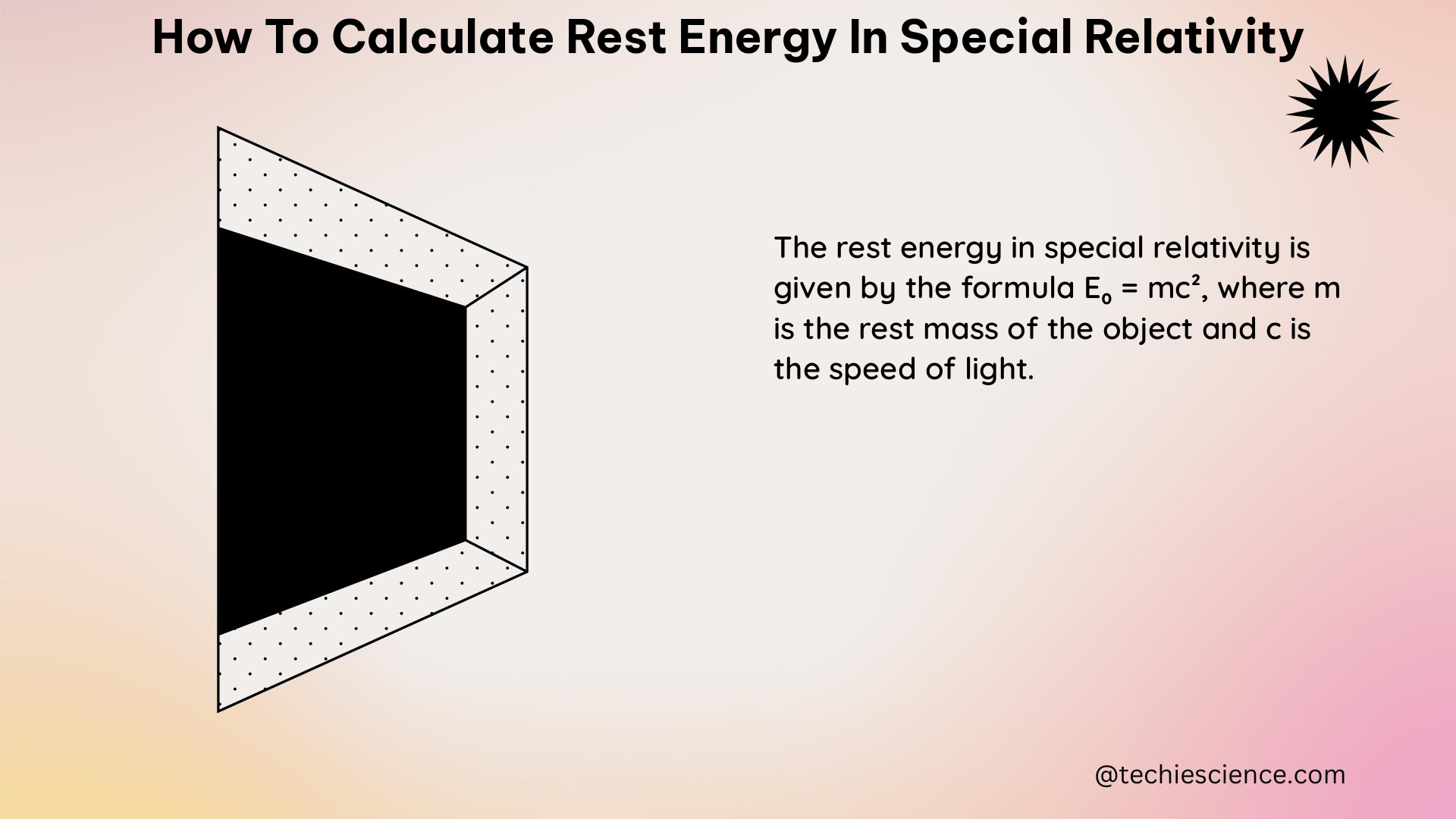In the realm of special relativity, the concept of rest energy plays a crucial role in understanding the fundamental nature of matter and energy. The rest energy, denoted as E₀, is the energy possessed by an object at rest relative to the observer. This energy is directly proportional to the object’s rest mass, m₀, and the speed of light, c, as described by the famous equation E₀ = m₀c².
Understanding the Rest Energy Formula
The formula for calculating the rest energy in special relativity is:
E₀ = m₀c²
Where:
– E₀ is the rest energy of the object
– m₀ is the rest mass of the object
– c is the speed of light in a vacuum, approximately 3 × 10⁸ m/s
This equation, derived from the principles of special relativity, reveals the remarkable relationship between mass and energy. It demonstrates that even a small amount of rest mass can be converted into a vast amount of energy, as evidenced by the enormous value of the speed of light squared.
Calculating Rest Energy: Examples

Let’s explore some examples to illustrate the calculation of rest energy in special relativity.
Example 1: Rest Energy of a 1.00-gram Mass
Given:
– Mass (m₀) = 1.00 g = 0.001 kg
Substituting the values into the formula:
E₀ = m₀c²
E₀ = (0.001 kg) × (3 × 10⁸ m/s)²
E₀ = 8.99 × 10¹³ J
Therefore, the rest energy of a 1.00-gram mass is approximately 8.99 × 10¹³ Joules.
Example 2: Rest Energy of a Proton
Given:
– Rest mass of a proton (m₀) = 1.67 × 10⁻²⁷ kg
Substituting the values into the formula:
E₀ = m₀c²
E₀ = (1.67 × 10⁻²⁷ kg) × (3 × 10⁸ m/s)²
E₀ = 1.50 × 10⁻¹⁰ J
Therefore, the rest energy of a proton is approximately 1.50 × 10⁻¹⁰ Joules.
Significance of Rest Energy
The concept of rest energy has profound implications in various fields of physics, particularly in the understanding of nuclear reactions and the conversion of mass to energy.
-
Nuclear Reactions: The enormous amount of energy stored in the rest mass of particles, as demonstrated by the E₀ = m₀c² equation, is the driving force behind nuclear reactions. In processes like nuclear fission and fusion, a small fraction of the rest mass is converted into kinetic energy, which is then harnessed for various applications, such as nuclear power generation.
-
Mass-Energy Equivalence: The rest energy equation highlights the fundamental equivalence between mass and energy, as proposed by Albert Einstein’s famous equation E = mc². This principle has revolutionized our understanding of the nature of the universe and has led to groundbreaking discoveries in fields like particle physics and cosmology.
-
Relativistic Effects: The rest energy formula is closely linked to the concept of relativistic effects, which become significant at speeds approaching the speed of light. As an object’s velocity increases, its rest mass increases, leading to a corresponding increase in its rest energy. This phenomenon has important implications in the study of high-energy particle physics and the behavior of objects moving at relativistic speeds.
-
Energy Storage and Conversion: The immense amount of energy stored in the rest mass of objects has potential applications in energy storage and conversion technologies. Researchers are exploring ways to harness this energy, such as through the development of advanced energy storage devices or the design of more efficient energy conversion systems.
Conclusion
The calculation of rest energy in special relativity is a fundamental concept that provides valuable insights into the nature of matter and energy. By understanding the E₀ = m₀c² formula and applying it to various examples, we can gain a deeper appreciation for the remarkable relationship between mass and energy, as well as its far-reaching implications in physics and beyond.
References
- OpenStax College Physics 2e. (2015). Special Relativity – The Expert TA. Retrieved from https://www.theexpertta.com/book-files/OpenStaxCollegePhysics2e/Chapter28.pdf
- Physics LibreTexts. (2024). 27: Special Relativity – Physics LibreTexts. Retrieved from https://phys.libretexts.org/Bookshelves/University_Physics/Physics_%28Boundless%29/27:__Special_Relativity/27.3:_Relativistic_Quantities
- Physics Stack Exchange. (2020). Where does rest energy fit into the calculation of total energy? Retrieved from https://physics.stackexchange.com/questions/547973/where-does-rest-energy-fit-into-the-calculation-of-total-energy

The lambdageeks.com Core SME Team is a group of experienced subject matter experts from diverse scientific and technical fields including Physics, Chemistry, Technology,Electronics & Electrical Engineering, Automotive, Mechanical Engineering. Our team collaborates to create high-quality, well-researched articles on a wide range of science and technology topics for the lambdageeks.com website.
All Our Senior SME are having more than 7 Years of experience in the respective fields . They are either Working Industry Professionals or assocaited With different Universities. Refer Our Authors Page to get to know About our Core SMEs.